Metanorma for IEEE SA markup
Clause structure
The following clause structure is mandated by the IEEE SA Style Manual.
-
Preface segments
-
Abstract and Keywords right after the inner cover page
-
Important Notices and Disclaimers Concerning IEEE Standards Documents
-
Participants
-
Introduction
-
Acknowledgements (optional)
-
-
1. Overview
-
1.1. Scope
-
1.2. Purpose (optional)
-
1.x. Word usage (last subclause of Overview)
-
-
2. Normative references
-
3. Definitions
-
4 and onwards. Document content.
-
Annex A (informative). Bibliography.
-
Annex B onwards. Document content.
Preface segments
Abstract
The abstract of the document is marked up as a clause with the style attribute
[abstract].
[abstract]
== Abstract
This standard is intended to promote and facilitate interoperability
between components of an automatic test system (e.g., between test
executive and diagnostic reasoner) where test results need to be shared.Keywords
The keywords of the document are given as the comma-delimited :keywords:
document attribute (see Document attributes).
Introduction
The introduction of the document is marked up as a clause with the title "Introduction". The initial boxed text, "This introduction is not part of P{designation}/D{draft_number}, Draft {document-type} for {par-title}" is automatically generated and populated by Metanorma. Do not provide it.
Acknowledgements
If the document refers to any externally sourced content that require permission or licensing acknowledgements, they are entered as a section with the title "Acknowledgements".
The "Acknowledgements" section shall appear immediately after the "Introduction", in accordance with the IEEE SA Style Manual (2021).
|
Note
|
The placement of the "Acknowledgements" section differs in legacy documents, some IEEE SA standards places it immediately before the "Introduction". |
== Acknowledgements
<<table2>> of this standard is printed with permission from BBN Corporation.Automatic generated content
The templated material ("boilerplate") of the document front matter is all automatically provided by Metanorma:
-
Front page: Copyright statement, license statement
-
Second page: Contact information, ISBNs
-
Important Notices and Disclaimers Concerning IEEE Standards Documents
-
Participants statement (the membership of the various committees is provided in a Participants clause)
-
The note before the overview in amendments, indicating how formatting is to be interpreted
Participants and contributors
General
There are multiple types of contributors to an IEEE SA document, and the document displays full provenance of where the document was developed, balloted and eventually approved.
|
Note
|
Requirements of the “Participants” section is described in the IEEE Style Manual, 11.5 "Participant lists". |
Other than the basic information entered through the document attributes on document contributors, the participants and members are entered in the “Participants” section.
An IEEE SA document requires listing of all members of the:
-
working group;
-
balloting group, whether the group is of entity mode or individual mode;
-
Standards Board (SASB), at the time of publishing the document;
-
any additional groups or individuals involved in the development process.
The Participants section is provided by the official IEEE template. Additional contributing groups and participants, if any, are permitted additions to the basic text.
In Metanorma, the participants section is entered as a top level section. The section contains paragraphs in the order specified in the above list.
The initial sentence before each of the Working Group, Balloting Group, and Standards Board listings is automatically supplied by Metanorma, following the defined pattern provided by the 2021 IEEE Style Manual.
The following members of the <individual/entity> balloting committee voted on this <guide/recommended practice/standard>. Balloters may have voted for approval, disapproval, or abstention.
where, the Metanorma-generated sentence describes the correct document type and the type of balloting group.
The remainder of the content is provided in three subclauses of the
== Participants clause supplied by the author:
-
=== Working group -
=== Balloting group, and -
=== Standards board:
== Participants
=== Working group
...
=== Balloting group
...
=== Standards board
...|
Note
|
The first == Participants clause found in a document will be processed
for boilerplate content, and removed from the document by Metanorma.
|
|
Note
|
If you have an actual clause titled == Participants which needs to be
left alone, insert [heading=clause] before it to prevent it being recognised
as a metadata Participants clause.
|
Representing participants
Participants can be entered in the following manners:
-
in an unordered list, where each list item is a personal name
Example 3. Example of representing individual participants in an unordered list* Nikola Tesla * Thomas Edison * Henry Ford -
in a definition list, with the key
itempointing to a name, as a personal nameExample 4. Example of representing individual participants in a definition listitem:: Claude Elwood Shannon item:: Charles-Augustin de Coulomb -
in a two-level definition list, where the key
itemempty, with sub-definitions containing key-value encoded attributes of the participant:-
namefor persons -
companyfor entities -
roleto describe the role of the participant. When noroleis provided, it is assumed to be "Member".
Example 5. Example of representing individual participants with roles and companiesitem:: name::: Arthur C. Clark role::: Chair item:: name::: Alessandro Volta role::: Vice-Chair item:: company::: Apple Inc. item:: Claude Elwood Shannon item:: Charles-Augustin de Coulomb -
Participant lists should be given in the order they will be rendered in:
-
officers before members;
-
organisation members before individual members.
Documents often insert additional lists of participants and acknowledgements. Any list or definition list in the user-supplied Participants clause is treated and processed the same way.
The Word and PDF rendering of the participants listings automatically works out the differential rendering of member organisations and individual members in two or three columns.
Working group
Working group participants are entered using the method in Representing participants.
For an individual mode working group, participants are entered using personal names.
// Officers
item::
name::: Justin Refice
role::: Chair
item::
name::: Mark Strickland
role::: Vice Chair
item::
name::: Jamsheed Agahi
role::: Secretary
item::
name::: Joel Feldman
role::: Technical Editor
// Individual participants
name::: Mala Bandyopahdyay
name::: Martin Barnasconi
name::: Dennis Brophy
name::: Cliff Cummings
//...Rendered as:
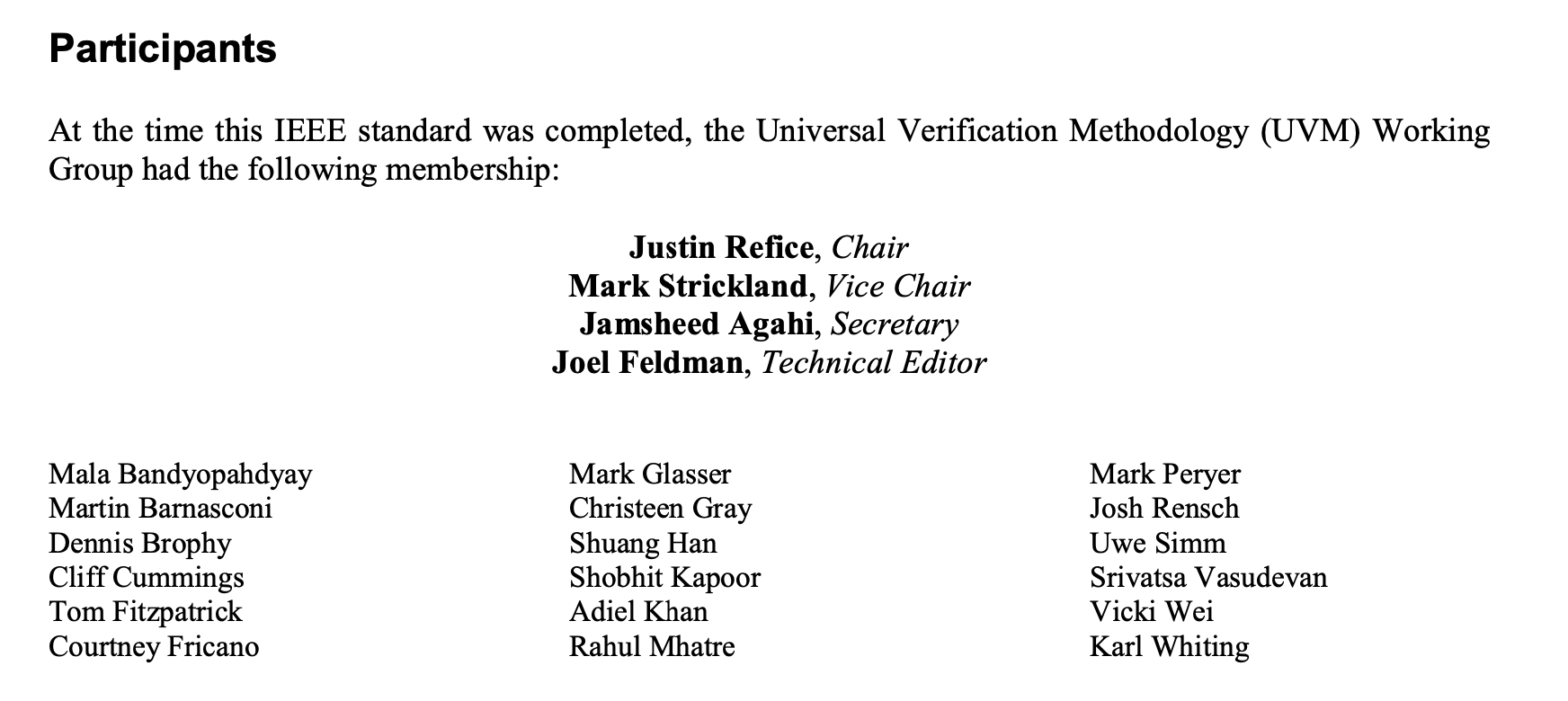
For an entity mode working group, there are two types of participants: entity representatives, and individuals.
Entity representative participants should be entered using both name with
company, and individual participants just with name.
Officers are to be entered with name, role and company.
// Officers
item::
name::: Jin Peng
role::: Chair
item::
name::: Cheng Hong
role::: Vice Chair
company::: Alibaba China Co. Ltd.
// Entity representative participants
item::
name::: Lei Wang
company::: Alipay (China) Technology Co., Ltd.
item::
name::: Guantong Su
company::: Arpacorp Limited
item::
name::: Xiaoru Li
company::: Beijng Baidu Netcom Science Technology Co., Ltd.
item::
name::: Bingzhe Wu
company::: Beijing University
// ...
// Individual participants
name::: Xiaoyuan Bai
name::: Yang Bian
name::: Wenting Chang
// ...Rendered as:
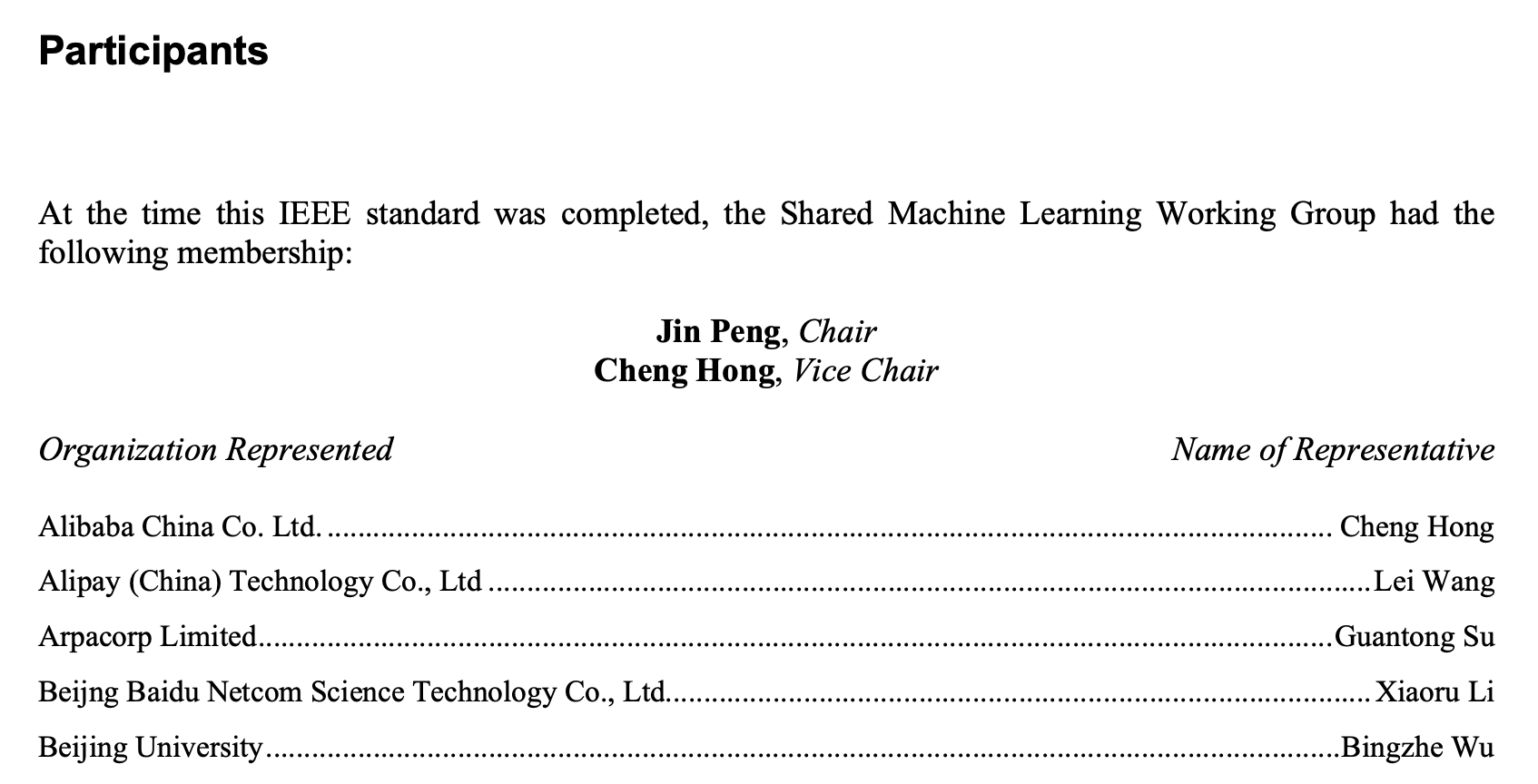
(continued)
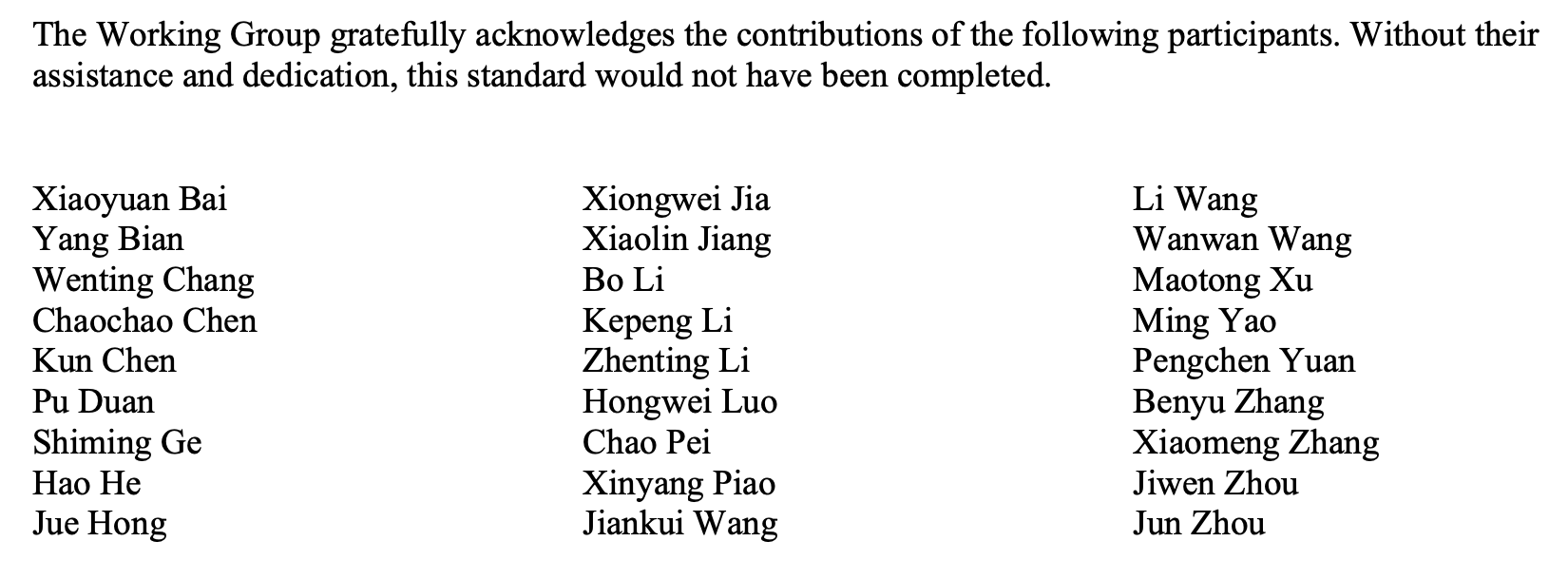
Balloting group
Balloting group participants are entered using the method in Representing participants.
There are two types of balloting groups.
In an individual working group, personal names are entered using the
name key.
The following two encodings are identical in effect.
* Robert Aiello
* Lennart Ask
* William Byrd
* Sandra Cannon
* Chris Cleet
* Jennifer Costley
//...item:: Robert Aiello
item:: Lennart Ask
item:: William Byrd
item:: Sandra Cannon
item:: Chris Cleet
item:: Jennifer Costley
//...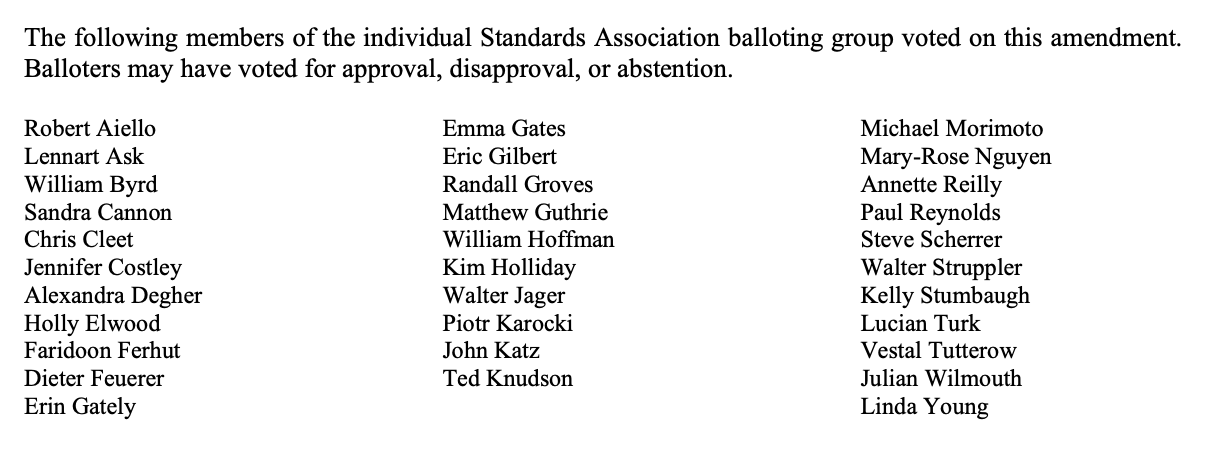
In an entity working group, organization names are to be entered using the
company key.
=== Balloting group
item::
company::: Accellera Systems Initiative, Inc.
item::
company::: Analog Devices Inc.
item::
company::: Cadence Design Systems, Inc.
item::
company::: Ericsson AB
item::
company::: Intel Corporation
item::
company::: Marvell Semiconductor, Inc.
//...
Standards board
Standards board members are entered using the method in Representing participants.
The IEEE SA Standards Board members are to be entered using name and
with role when appropriate. Member Emeritus is entered with attaching
an asterisk (*) at the end of the name.
The paragraph explaining the asterisk indicates Member Emeritus is inserted automatically by Metanorma.
// Officers
item::
name::: Gary Hoffman
role::: Chair
item::
name::: Jon Walter Rosdahl
role::: Vice Chair
item::
name::: John D. Kulick
role::: Past Chair
item::
name::: Konstantinos Karachalios
role::: Secretary
// Board members
item:: Ted Burse
item:: Doug Edwards
item:: J. Travis Griffith
item:: Grace Gu
item:: Guido R. Hiertz
item:: Joseph L. Koepfinger*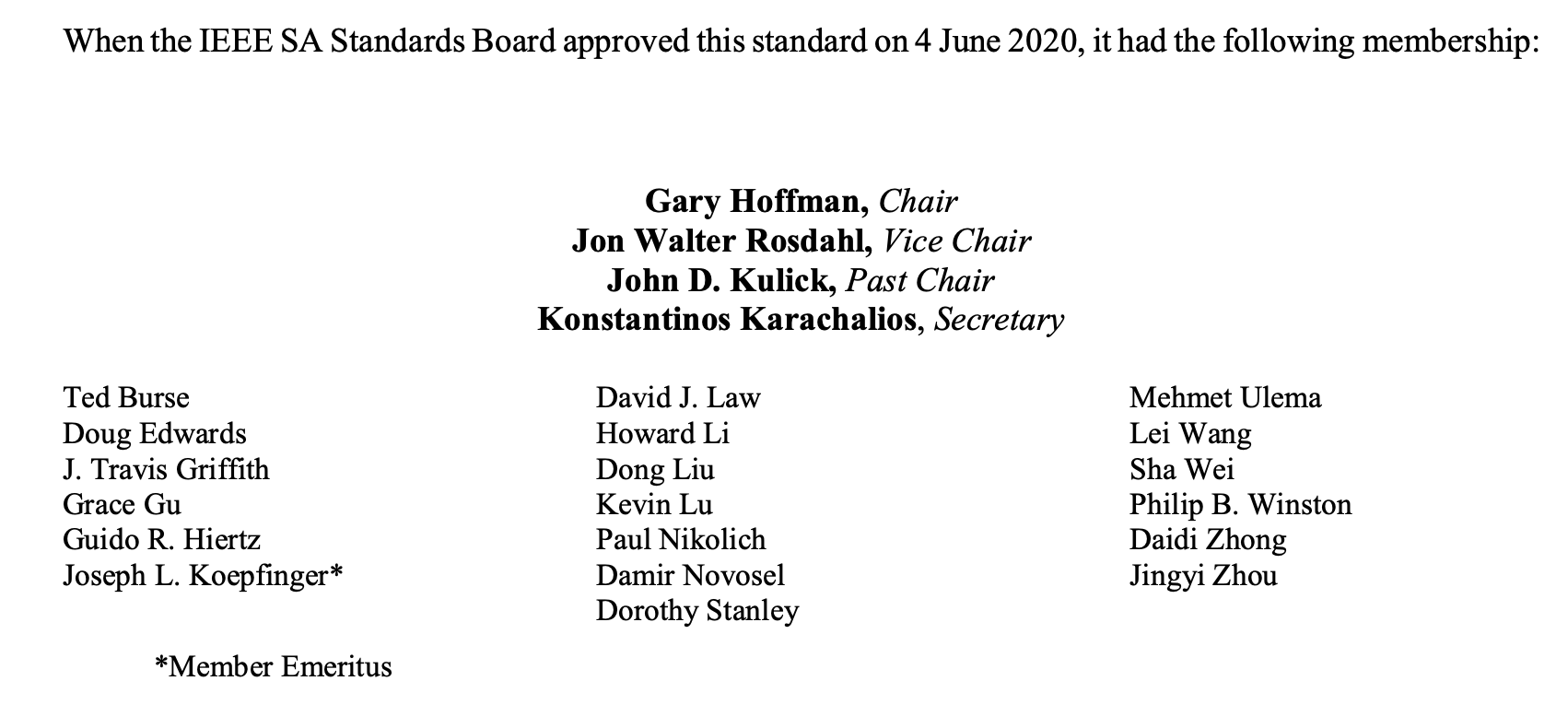
|
Note
|
The standards board membership is provided by the working group secretary or the IEEE editor during editing. If the information is not provided in the document, dummy values will be provided to match those in the IEEE templates. |
Name markup
The forenames and surnames of participants should be marked up semantically as such,
for correct generation of Word styles. This is done with the markup
span:surname[], span:forename[], and [added in https://github.com/metanorma/metanorma-ieee/releases/tag/v1.2.1].
There is no need to mark up the role of participants or their status as companies, as this is already semantically
differentiated in markup.
item::
name::: span:forename[Justin] span:surname[Refice]
role::: Chair
item::
name::: span:forename[Mark] span:surname[Strickland]
role::: Vice ChairOverview
The Overview clause, and its subclauses are recognized automatically from the supplied clause headers.
The subclauses recognized include:
-
Scope
-
Purpose
-
Word usage
The Word Usage subclause is mandatory for normal documents (as distinct from amendments and corrigenda), and is auto-populated by Metanorma. There is no need to encode it.
References
The introductory paragraph for normative references and bibliographies is automatically generated by Metanorma.
References are automatically sorted by Metanorma:
-
Normative references are automatically sorted by designator.
-
Bibliography references are automatically sorted by designators or author and title.
Footnotes are automatically inserted for withdrawn IEEE references, and for references from Standards Defining Organizations recognised in Relaton [added in https://github.com/metanorma/metanorma-ieee/releases/tag/v1.1.11].
The bibliography is entered as a subclause of an annex: the bibliography heading is overwritten by the annex heading, but it must still be given as "Bibliography" to be recognised correctly.
[appendix]
== Bibliographic excursus
[bibliography]
=== BibliographyDefinitions clause
General
Definitions are recognised as a clause with the title "Definitions" or "Terms and definitions".
Definitions are automatically sorted by Metanorma in accordance with the IEEE SA Style Manual.
The notation for subdefinitions and cross-references in Metanorma is demonstrated in the following example.
Metanorma supports concepts, which capture terms are cross-referencable entities, including cross-references within the Definitions sections.
|
Note
|
Highlighting and cross-referencing of concepts is not supported in Metanorma for IEEE, in accordance with the IEEE SA Style Manual. |
=== widget
preferred:[WgT]
related:contrast[thing] // Contrast:
related:seealso[whatsit] // See also:
[.definition]
device performing an unspecified function.
[.definition]
general metasyntactic variable.renders as:
widget (WgT): (A) device performing an unspecified function. (B) general metasyntactic variable. See also: whatsit. Contrast: thing.
Multiple definitions
IEEE SA documents supports multiple definitions per term.
Each definition is encoded using the [.definition] block.
=== output
[.definition]
Data that has been processed.
[.definition]
The process of transferring data from an internal storage device to an external
storage device.renders as:
output: (A) Data that has been processed. (B) The process of transferring data from an internal storage device to an external storage device.
Concept relations
Synonyms
Synonyms are entered using preferred:[…] or admitted:[…].
A preferred term is intended to introduce equally valid term designations, such
as abbreviations and acronyms such as acronyms. Preferred terms are encoded
preferred[...].
These are displayed in parentheses after the initial term.
An admitted term is intended for synonyms. Admitted terms are encoded using
admitted:[...].
These are displayed using the concept relation See:, where an additional term
is automatically inserted into the clause.
|
Note
|
See: terms are the opposite relations to Syn: relations, and the generated relation will point the See: term’s definition back at the original term. Please do not manually insert markup for See: terms. |
=== coded character set
admitted:[code set]
A set of characters for which coded representation exist.renders as:
code set: See: coded character set.
coded character set: A set of characters for which coded representation exist. Syn: code set.
=== widget
preferred:[WgT]
admitted:[doovywhack]
device performing an unspecified function.renders as:
doovywhack: See: widget.
widget (WgT): device performing an unspecified function. Syn: doovywhack.
Contrast
A contrasting term is one that describes an opposite meaning to the designated definition.
=== input reference axis
related:contrast[output reference axis]
The direction of an axis as defined by the case mounting surfaces, external case
markings, or both.renders as:
input reference axis: The direction of an axis as defined by the case mounting surfaces, external case markings, or both. Contrast: output reference axis.
See also
=== acceleration-insensitive drift rate
related:seealso[drift rate]
related:seealso[systematic drift rate]
The component of systematic drift rate that has no correlation with acceleration.renders as:
acceleration-insensitive drift rate: The component of systematic drift rate that has no correlation with acceleration. See also: drift rate; systematic drift rate.
Equivalence
An equivalent term is meant to cross-reference pre-existing term definitions.
Equivalent terms are encoded using the relation related:equivalent[…].
Term sources
Term sources are encoded using the [.source] syntax, and rendered within
parentheses after the definition according to the IEEE SA Style Manual.
=== systematic drift rate
That component of drift rate that is correlated with specific operating
conditions.
[.source]
<<IEEE-260-1-2004>>renders as:
systematic drift rate: That component of drift rate that is correlated with specific operating conditions. (IEEE Std 260.1-2004)
For terms that are modified or adapted from the source, they are encoded as
"adapted from" through an adapted option on the source tag.
=== drift rate
The slope at a stated time of the smoothed curve of tube voltage drop with time
at constant operating conditions.
[.source%adapted]
<<iso-iec_9945-1>>rendered as
drift rate: The slope at a stated time of the smoothed curve of tube voltage drop with time at constant operating conditions. (Adapted from ISO/IEC 9945-1:2003)
Annexes
Normative and informative annexes are differentiated with the obligation
attribute:
[appendix,obligation=normative]
== Rules for implementation
[appendix,obligation=informative]
== Suggestions for implementationBibliographies are encoded as the children of informative annexes; Metanorma will take care of rendering the annex title properly, without a redundant subclause.
[appendix,obligation=informative]
== Bibliography
[bibliography]
=== BibliographyBlocks
Notes
The footnote on first appearance of a note,
Notes to text, tables, and figures are for information only and do not contain requirements needed to implement the standard.
is automatically generated by Metanorma.
Tables
Table heads and table subheads are marked up as header cells. They are differentiated by line break:
|===
| Header1 | Header2
h| Table Row Head +
Table Row Subhead | ValueInline
Cross-references
Omission of "clause" at the start of a sentence for cross-references to
subclauses is done automatically by Metanorma. If Metanorma’s detection of the
start of a sentence is incorrect, you can override Metanorma’s auto-generated
text, by providing it explicitly within the cross-reference, e.g.
Clause 3.1.
References to the bibliography are automatically populated by designator and bibliographic number (e.g. ISO 639-2, [B1]),
if the reference is to a standard or technical report, or otherwise by title and bibliographic number. If you wish to
override that, e.g. by using authors instead of title, you should populate the cross-reference text, e.g.
Boswell and Johnson [B2].
Footnotes
If a footnote is repeated, Metanorma automatically detects that and converts it into a cross-reference ("See Footnote 1.")
A repeat footnote can be marked up using the footnote macro target (abc in
the following example; any identifier can be used), and with the repeat footnote
text left blank.
Hello.footnote:abc[This is a footnote]
Repetition.footnote:abc[]Validation
Metanorma issues warnings for the document against the following rules from the Style Manual:
-
The title of the document starts as "(Draft) (Trial-Use) (Standards|Recommended Practice|Guide)" (11.3). This is done automatically by Metanorma if all the relevant document attributes are populated.
-
The title contains no uncapitalized words other than prepositions (11.3).
-
No cross-reference ranges are used: "See Figure 1, Figure 2 and Figure 3", not "See Figures 1 through 3" (17.2). This is only checked against autonumbered cross-references.
-
Undated references should not contain identify specific elements of the referenced text (12.3.2).
-
Normative references should be dated (12.3.1).
-
There should be no more than one ordered list within a numbered clause (13.3).
-
The names of supplied images in figures and tables must follow the prescribed naming conventions (17.1).
-
Figure headings should be capitalized (17.2).
-
The document must contain an Overview clause, a Scope clause, a Word Usage clause (12.2).
-
The Overview clause must occur first, and contain the Scope clause and the Word Usage clause (12.2).
-
There should be no more than five levels of subclauses (13.1).
-
No subclause should be the only child of its parent (13.1).
-
Decimal comma should not be used (14.2).
-
Decimals must have a leading zero if less than 1 (14.2).
-
There must be space before the percent sign (14.2).
-
There must be space between numerals and recognised SI units (14.2).
-
Units must be given on both value and tolerance for an SI unit (14.2).
-
Numbers occurring in tables should be broken up in threes, unless they are four-digit sequences and all other digits are at most three digits (16.3.2).
-
Table headings and header cells should be capitalized (16.2).
-
The document should contain Normative Refences and Definitions (12.2).
-
The bibliography should be either the first or the last annex of the document (19.1).
-
Amendment/corrigenda changes should start with one of Change, Insert, Delete, Replace, reflecting the kind of change involved (20.2.2). [added in https://github.com/metanorma/metanorma-ieee/releases/tag/v0.1.0]
-
Unordered lists should be no more than two levels deep.
-
Ordered lists should be no more than five levels deep.